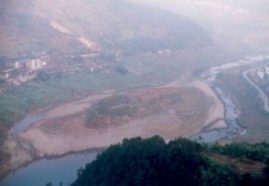Salt and Early Civilization
Evidence from China suggests that people were making salt at least 4,000 years ago.
Share this:
- Share via email (Opens in new window) Email
- Click to share on Facebook (Opens in new window) Facebook
- Click to share on X (Opens in new window) X
- Click to share on Pinterest (Opens in new window) Pinterest
- Click to share on Reddit (Opens in new window) Reddit
- Share to Google Classroom (Opens in new window) Google Classroom
- Click to print (Opens in new window) Print
By Emily Sohn
Before salted fries came out of drive-through windows, before salty pretzels sat on the shelves of every grocery store, before there was a saltshaker on every dinner table, people had to go to a lot of trouble to get salt.
Archaeologists have now uncovered the earliest strong evidence of salt production ever found. It suggests that large-scale salt making occurred at least 4,000 years ago in a settlement in central China.
 |
|
This aerial view shows a mound beside a river that contains the remains of a site in central China where salt making occurred 4,000 years ago. |
| Rowan Flad/Proceedings of the National Academy of Sciences |
The new evidence comes out of the ruins at Zhongba, a settlement along the salty Ganjing River. Artifacts include pieces of vessels that were used to boil river water. Boiling salty water causes the water to evaporate, leaving behind cakes of salt.
The oldest objects from Zhongba, dating back to between 2000 B.C. and 1750 B.C., include vats with pointy bottoms that were used to either store or boil salt water. From the period between 1630 B.C. and 1210 B.C., the researchers found lots of small cups with pointy bottoms. These were probably molds for making salt cones for trading.
From the period between 1100 B.C. and 200 B.C., the archaeologists dug up small jars with round bottoms. People still use jars like this in some parts of the world to boil salt water and make salt cakes.
Chemical analyses of the river water and of the soil in pits at Zhongba provide further evidence of salt making. Remains inside the round-bottomed jars seem to be calcium oxide, a chemical that forms during the salt-making process. There were also tiny traces of salt inside many of the vessels found at the site.
Learning how to produce large amounts of salt helped the Chinese develop cities and build empires, the scientists say. Back when salt and salted foods were hard to come by, the crystal seasoning was worth a lot, and the Chinese traded it for other goods.
Now that they have the technology to do it, archaeologists want to look for signs of salt making at even older sites in the Middle East. Even as nutritionists today warn that people are eating too much salt, the history of the seasoning has a lot to say about the development of cultures around the world.—E. Sohn
Going Deeper:
Bower, Bruce. 2005. A seasoned ancient state: Chinese site adds salt to civilization’s rise. Science News 168(Aug. 27):132-133. Available at http://www.sciencenews.org/articles/20050827/fob4.asp .
You can learn more about salt and its history at www.saltinstitute.org/38.html (Salt Institute), www.saltsense.co.uk/aboutsalt01.htm (Salt Manufacturers’ Association), and www.historyforkids.org/learn/food/salt.htm (History for Kids).






